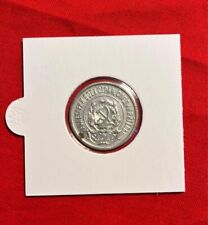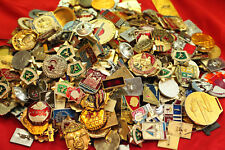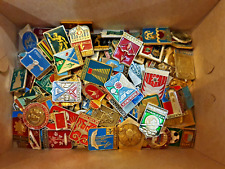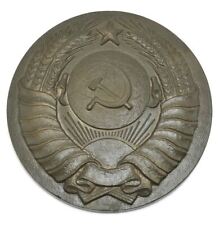|

On eBay Now...
SOVIET USSR RUSSIA VINTAGE MUSEUM RARE SAMOVAR SPUTNIK SPACE SATELLITE SATURN For Sale

When you click on links to various merchants on this site and make a purchase, this can result in this site earning a commission. Affiliate programs and affiliations include, but are not limited to, the eBay Partner Network.

SOVIET USSR RUSSIA VINTAGE MUSEUM RARE SAMOVAR SPUTNIK SPACE SATELLITE SATURN:
$1399.00
SOVIET USSR RUSSIA VINATAGE MUSEUM RARE SAMOVAR SPUTNIK SPACE SATELLITE SATURNA samovar in the form of the 1st space artificial satellite Sputnik thee pot on top in form of planet Saturn.
Beautiful set, a real eye catcher. A Must have collectors item. Seen in the museums.100% Original SovietSamovar in the Form of"Sputnik 1" ("Спутник-1") Satellite EXTREMELY RARE PIECE OF SOVIET SPACE MEMORY! NOT PRODUCED ANYMORE! One of the rarest electro samovars in the world, which is dedicated to Soviet space program, lunching the first artificial Earth satellite "Sputnik 1" in 1957. Designed to heat 2.5 litres of water. The creator of this unique Samovar was Constantin Sobakin. It was made in the Soviet Suksun city in 1978, as written on the samovar itself. Samovar has been produced for a short period of time. Not produced anymore!It is new and never used samovar since 1978. Excellent vintage condition! Great find for collectors! P.S. You can find the same samovar at "The Cosmonauts: Birth of the Space Age" exhibition at the Science Museum in London (see the last photo).
About "Sputnik 1" Satellite Sputnik 1was the firstartificial Earth satellite. TheSoviet Unionlaunched it into an ellipticallow Earth orbiton 4 October 1957. It was a 58cm (23in) diameter polished metal sphere, with four external radio antennae to broadcast radio pulses. It was visible all around the Earth and its radio pulses were detectable. This surprise success precipitated the American<="Sputnik crisis" style="text-decoration: none; background-image: none;">Sputnik crisisand triggered theSpace Race, a part of the largerCold War. The launch ushered in new political, military, technological, and scientific developments. Sputnikitself provided scientists with valuable information, even though it was not equipped with scientific instruments. The density of the upperatmospherecould be deduced from its<" title="Aerodynamic drag" style="text-decoration: none; background-image: none;">dragon the orbit, and the propagation of its radio signals gave information about theionosphere. Sputnik 1was launched during theInternational Geophysical YearfromSite No.1/5, at the 5thTyuratamrange, inKazakh SSR(now at theBaikonur Cosmodrome). The satellite travelled at about 29,000 kilometres per hour (18,000mph; 8,100m/s), taking 96.2 minutes to complete each orbit. It transmitted on 20.005 and 40.002MHzwhich were monitored byamateur radiooperators throughout the world.The signals continued for 21 days until the transmitter batteries ran out on 26 October 1957.Sputnik 1burned up on 4 January 1958, as it fell from orbit upon reenteringEarth's atmosphere, after travelling about 70 million km (43.5 million miles) and spending three months in orbit.
Great condition seen in pictures. Full set
Shipping : worldwide (tracking)
Payment : PaypalSoviet Space history:1. First visionaries of space
The Russian race to space didn’t start from laboratories, but from an intellectual Russian movement of the early 20s. Calling themselvesCosmopolitans, they followedKonstantin Tsiolkovsky‘s pioneering work in rocketry, and set the root for what was to be a thrilled answer to the astonoshing event of the firstrocket designed byGerman scientist Werner von Braun, which entered into space on October 3rd, 1942. In thosetwenty years, from the theorization of space flight to the actual event,Russian intellectuals did not remain idle:in 1923, the newspaper Izvestiiahad published an article on spaceflight theories of Hermann Oberth and Robert Goddard, entitled ‘Is Utopia Really Possible?’, prompting a flourishing ofarticles, nonfiction books andscience fiction novels, such as Alexey N. Tolstoy‘s Aelita. Soon, Cosmopolitans were replaiced byCosmism, a less universal and more nationalist philosophy developed by Tsiolkovsky himself and Nikolai Fedorov. The idea that Soviets were to be masters of the cosmos started to take roots. Cosmists goals were simple enough: colonizing space,populating the universe with Russians andachieving eternal life by understanding the secrets of time itself. They becamean institution and, after requisitioning a shop in Moscow, they set up a shop later known asthe World’s First Exhibition of Models of Interplanetary Apparatus, Mechanisms, Instruments, and Historical Materials. The exhibition had a huge impact on popular culture and set the stage for what was to become a national fever upon the succesful launch of Sputnik.2. Sputnik: the first artificial satellite
On October1957, Soviet Russia launched its first satellite into space. It was called спутник, Sputnik, and it was a sphere of 58 cm of diameter, built in aluminium. Its shape rapidly entered popular imagination as much as it entered Western fashion, andSoviet premier Nikita Khrushchev elected it to his symbol of a new, progressive, science-driven Russia.Sputnik chandeliers are still named after the satellite.3. Laika: first dog in space
After the succesful launch of Sputnik, Khrushchev put pressure on the space program and requested three goals to be achieved in the next decade: they had been first in launching a satellite, by beating US’Explorer 1 launched on January 31st 1958, and they would have been the firsts to launch a living beingin orbit, to execute a lunar flybys and to launch a probe to Venus.The first of these races was won by technicality, as NASA launched drosophilae (seriously) but URSS launched dogs. The first dog to enter space was Laika, a month after Sputnik, in what was designed as a one-way trip just to find out if a living being could sustain a launch into space. The dog was given enough supplies to last a week, even if they had no mean to bring her back, but she died a few hours after entering orbit, of overheat.Belka and Strelka followed her three years after, and in1960 they completed their journey: 18 orbits after which they returned to earth safely, though a little shaken. The dogs became a tremendous force in PR: one ofStrelka’s puppies, Pushinka, was given by Nikita Khrushchev to Jacqueline Kennedy in June 1961, as a token of space rivalry, two months after URSS had won the race to send the first ma into space.4. Yuri Gagarin: first man in space
On April 12th, 1961, the now famous spacecraft which carried the first man in space, the Vostok 1, was carried in orbit on top of an adapted intercontinental ballistic missile, theSemyorka. On board, formerAir Force pilot Yuri Gagarin, choosen for the mission from agroup of 20 other Russians, mainly for his charisma and working class background.Vostok 1departed from Baikonur Cosmodrome, currentlyKazakhstan, and entered orbit on April 12th, 6.18 a.m., 11 minutes after launch. Gagarin mission lasted108 minutes and, though his landing was not without incidents, he returned on Earth unharmed. His mission had tremendous impact on PR relationship as he became a cultural ambassador, but by1962 he had returned to Russian Air Forceattaining the rank of Colonel. He died six years later, in 1968, during the crash of aMiG-15UTI jet je was piloting for a routine test. His name is still celebrated, both inRussia and in the former Soviet countries: every April 12th is Cosmonautics Day, and celebrations include a Yuri’s Nightwith film screenings and parties. 5.Valentina Tereshkova: first woman in space
22 year oldValentina Tereshova was selected after a long round of research and recruitment, began in1962bythe Soviet Air Force in order to conquer another achievement ahead of the Americans and create a heroine torepresent the virtues of the communist system, including gender equality. Tereshova was good-looking,a model worker and from a proletarian background, therefore was chosen in spite of other candidates having slightly better scores, such asValentina Ponomareva, a pilot anda graduate of the Moscow Aviation Institute. Alongside them, the other reserve wasIrina Solovyova,member of the Soviet national parachuting team. By president Sergei Korolev‘s own admission,Tereshova was picked for her outstanding personality and ability to influence a crowd, arousing sympathy. After her succesful journey inVostok 6, she became a cultural ambassador, travelling in Western Europe and US, while the Female Cosmonaut Detachment was disbanded without any furthermission. 6.Alexei Leonov: first man to walk in space
OnMarch 18th, 1965, Alexei Leonov was the very first man to step outside his spacecraft to take a walk in the void of space. Leonov mission came after a row of unsuccessful missions, such as the unmannedVoskhod Cosmos 57destroyed by its ownself-destruct anti-American mechanism, and wasn’t without perils: hisspacesuit inflated while in space, human manouvering mistakes were made,the descent module’s hatch didn’t seal properly, automatic guidance system failed. Still, he and his crewmatePavel Belyayev returned safely on Earth aftera manual descent the craft wasn’t designed to sustain. They landed in Kazakhstan’s Siberia, about 180 km from Perm, where they would have ironically been eaten by bears. Still, they were saved in time by a rescue team on skiis.Voskhod 2beatedUS Project Gemini spacewalk by three months.In 1975, US and USSR launched the first joint flight, the Soyuz-Apollo mission, andAlexei Leonov wasthe commander of the Russian crew. Leonovis currently 81 years old. 7. Game Over: Apollo 11 lands on the moon
With US succesful mission on the Moon, in 1969, the race was over.By the end of the 1970s space travel had lost its novelty and was no longer pushed forward by cold war. Slowly, Russia’s space program declined, as the Country faced other threats.


Soviet/USSR Military Hats x3 and Flag $109.00

Soviet USSR Stalin “Death Sentence” 20 Kopek Silver Coin for Coin Collecting $29.99

Lot of 50 pcs USSR SOVIET ERA ENAMEL PINS, BADGES COLD WAR COMMUNISM CCCP $29.98

Soviet Union Ushanka winter cap/ hat for the military of the Red Army USSR $50.00

Set 100 Pcs of LOT COLLECTION RUSSIAN SOVIET BADGE PIN USSR $32.00

USSR .Russian Soviet Commemorative Pin 70 Years Of The Formation Of The USSR. $3.00

USSR CCCP Soviet Crest Wall Plaque $89.99

Soviet Russian Propaganda Porcelain Book $159.00
|